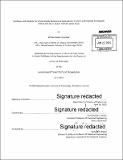Synthesis and catalytic structure activity relations of hydrophobic zeolites with isolated framework metals that act as water tolerant Lewis acids
Author(s)
Gunther, William Robert
DownloadFull printable version (18.41Mb)
Other Contributors
Massachusetts Institute of Technology. Department of Chemical Engineering.
Advisor
Yuriy Roman-Leshkov.
Terms of use
Metadata
Show full item recordAbstract
Catalysis provides a technology-based method to efficiently convert raw materials to useful products. Zeolite catalysis enables high product selectivity and is widely used due to the high activity, thermal stability, and well-defined crystalline pore structure of zeolites. Moreover, incorporation of metals into the framework of hydrophobic zeolites results in water-tolerant Lewis acids. This thesis discusses the synthesis, characterization, and structure-activity relations of metal-substituted Beta zeolites in the conversion of oxygenates. Chapter 2 discusses the application of dynamic nuclear polarization (DNP) NMR to characterize natural-abundance Sn-Beta. An indirect use of proton spin diffusion resulted in a 50-fold signal increase and the ability to observe natural-abundance ¹¹⁹Sn-Beta in <24 h. Since DNP NMR only enables efficient detection of spin-1/2 nuclei, a secondary method of adsorbing pyridine on framework metal sites in zeolites permits further characterization of quadrupolar nuclei. Chapter 3 examines how pyridine chemical shift can resolve framework and extraframework metal sites as well as provide a measure of Lewis acidity. Additionally, solid-state NMR offers the ability to quantify the concentrations of these sites. Promoter addition to the active sites of zeolites can further provide cooperative catalysis and tuning of product distribution. Chapter 4 describes the borate-promoted Sn- Beta zeolite-catalyzed conversion of aldoses via an unusual 1,2 carbon shift mechanism. The addition of a borate promoter to Sn-Beta resulted in a complete shift towards near-equilibrium epimerization product distribution. Chapter 5 further examines the catalytic consequences of varying key reaction parameters such as the borate to sugar ratio, pH, and reaction time. This full factorial experimental design showed that epimerization dominates under neutral conditions and is still active at substoichiometric borate to sugar ratio. This observation suggests that borate is acting pseudo-catalytically potentially through interaction with the Sn site. These findings motivated a detailed mechanistic study, as discussed in Chapter 6. Solid-state NMR proximity measurements in conjunction with directed removal of substrate functionality led to a proposed Bilik-type reaction mechanism involving borate. This body of work contributes to a molecular-level understanding of Lewis acid sites in hydrophobic zeolites. Furthermore, the ability to tailor Lewis acid sites through promoter incorporation can enable novel catalytic reactions.
Description
Thesis: Ph. D., Massachusetts Institute of Technology, Department of Chemical Engineering, 2015. Cataloged from PDF version of thesis. Includes bibliographical references (pages 111-122).
Date issued
2015Department
Massachusetts Institute of Technology. Department of Chemical EngineeringPublisher
Massachusetts Institute of Technology
Keywords
Chemical Engineering.